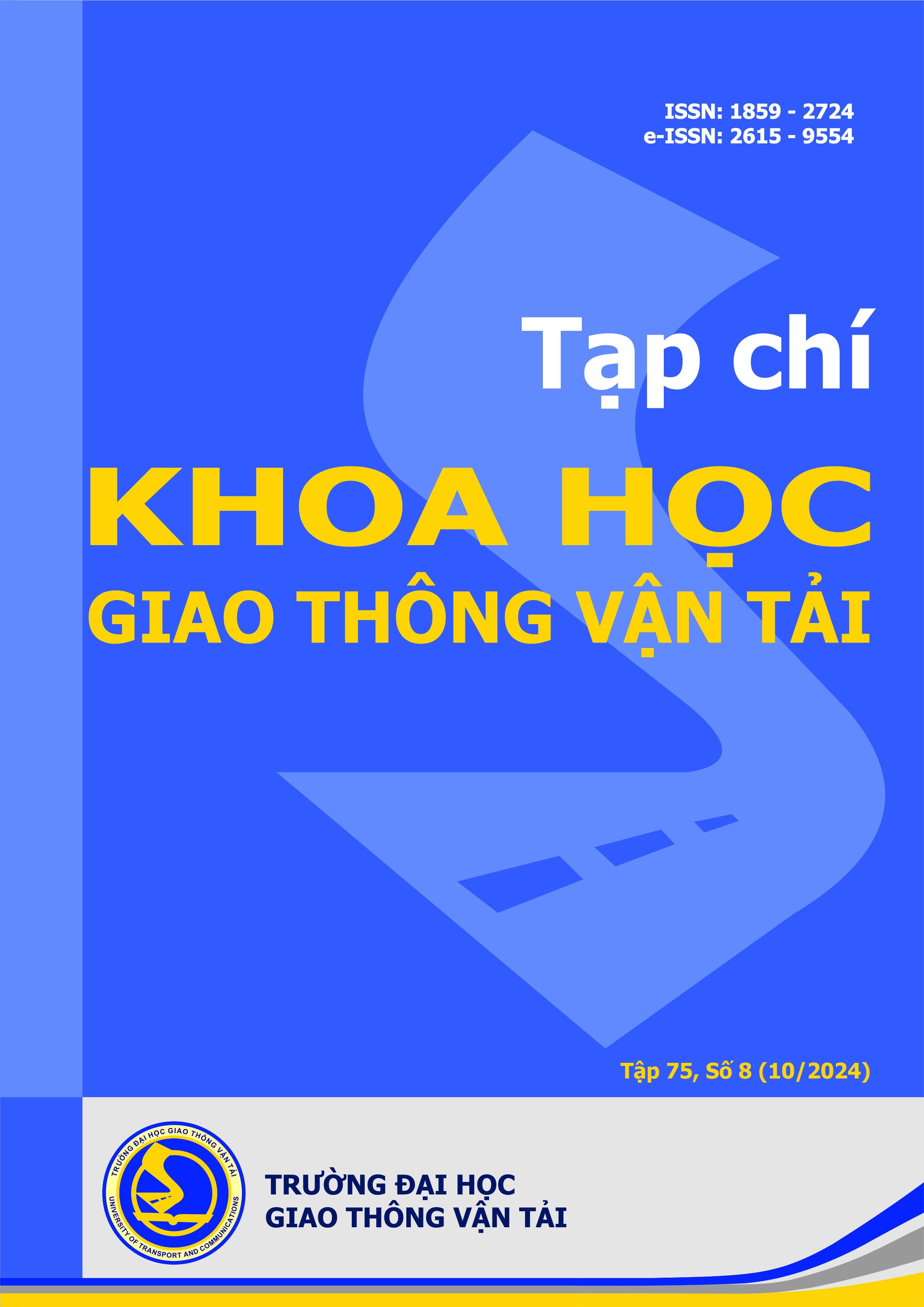Điều khiển tốc độ xe điện trên cơ sở bộ điều khiển bền vững PID
Email:
haiktd@utc.edu.vn
Từ khóa:
PID - bộ điều khiển tỷ lệ vi tích phân, EV – xe điện, NPID – bộ điều khiển PID phi tuyến, điều khiển bền vững
Tóm tắt
Thiết kế bộ điều khiển tốc độ của EV (electric vehicle) là hướng nghiên cứu quan trọng, qua đó giúp tăng hiệu suất của một EV. Bài báo này đưa ra phương pháp thiết kế bộ điều khiển tốc độ của xe điện trên cơ sở bộ điều khiển bền vững PID (R-PID). Đầu tiên từ mô hình phi tuyến của xe điện tiến hành khảo sát nhận dạng để đưa mô hình phi tuyến của xe điện thành mô hình tuyến tính với các bất định tham số. Tổng hợp bộ điều khiển PID cho mô hình đối tượng ở các tham số trung bình. Tiếp theo thiết kế bộ điều khiển tốc độ R-PID theo quan điểm tham số kD giả định biết trước, các tham số kP và kI được tính toán bằng phương pháp phân miền D. Hiệu quả của bộ điều khiển R-PID đã thiết kế được đánh giá thông qua mô phỏng hệ thống điều khiển tốc độ của xe điện bằng phần mềm Matlab-Simulink với mô hình phi tuyến của xe. Bộ điều khiển R-PID đã điều khiển ổn định được tốc độ của xe điện với mô hình xe phi tuyến và có bất định một số tham số của động cơ truyền động và của xe điện. Bộ điều khiển R-PID có tính đơn giản và dễ áp dụng vào thực tếTài liệu tham khảo
[1]. M. A. Shamseldin, Design of Auto-Tuning Nonlinear PID Tracking Speed Control for Electric Vehicle with Uncertainty Consideration, World Electric Vehicle Journal, 14 (2023) 78. https://doi.org/10.3390/wevj14040078
[2]. M. A. Shamseldin, M. A. Ghany, Y. H. Hossamel-din, Optimal Nonlinear PID Speed Control Based on Harmony Search for an
Electric Vehicle, Future Engineering Journal, 2 (2021) 2314-7237. https://digitalcommons.aaru.edu.jo/fej/vol2/iss1/4
[3]. N. Vafamand, M. M. Arefi, M. H. Khooban, T. Dragicevic, F. Blaabjerg, Nonlinear Model Predictve Speed Control of Electric Vehicles Represented by Linear Parameter Varying Models with Bias terms, IEEE Journal of Emerging and Selected Topics in Power Electronics, 7 (2019) 2081-2089. https://doi.org/10.1109/JESTPE.2018.2884346
[4]. M. H. Khooban, N. Vafamand, T. Niknam, T-S fuzzy model predictive speed control of electrical vehicles, ISA Transactions, 64 (2016) 231-240. http://dx.doi.org/10.1016/j.isatra.2016.04.019
[5]. S. Agrawal, V. Shrivastava, Speed Control of Electric Vehicle Using Fuzzy Logic Controller, IEEE, International Conference on Information, Communucation, Instrumentation and Control, (2017). https://doi.org/10.1109/ICOMICON.2017.8279036
[6]. V. Sharma, S. Purwar, Nonlinear Controllers for a Light-Weighted All-Electric Vehicle Using Chebyshev Neural Network, International Journal of Vehicular Technology, 2014 (2014) 867209. https://doi.org/10.1155/2014/867209
[7]. F. Oudjama, A. Boumediene, K. Saidi, D. Boubekeur, Robust Speed Control in Nonlinear Electric Vehicles Using H-Infinity Control and the LMI Approach, Journal of Intelligent Systems and Control, 2 (2023) 170–182. https://doi.org/10.56578/jisc020305
[8]. T. Pourseif, M. Mohajeri, Design of robust control for a motor in electric vehicles, IET Electrical Systems in Transportation, 10 (2020) 68-74. https://doi.org/10.1049/iet-est.2018.5084
[9]. L. H. Lân, N. V. Tiềm, Hệ thống điều khiển tuyến tính, NXB GTVT, Hà Nội, 2024.
[10]. N.P. Petrov, B.T. Polyak, Robust D-partition, Automation and Remote Control, 11 (1991) 41-52.
[11]. Nguyễn Văn Tiềm, Lê Hùng Lân, Thiết kế bộ điều khiển tốc độ bền vững cho xe lai điện trên cơ sở logic mờ, Tuyển tập báo cáo Hội nghị VCCA 2024, (2024).
[2]. M. A. Shamseldin, M. A. Ghany, Y. H. Hossamel-din, Optimal Nonlinear PID Speed Control Based on Harmony Search for an
Electric Vehicle, Future Engineering Journal, 2 (2021) 2314-7237. https://digitalcommons.aaru.edu.jo/fej/vol2/iss1/4
[3]. N. Vafamand, M. M. Arefi, M. H. Khooban, T. Dragicevic, F. Blaabjerg, Nonlinear Model Predictve Speed Control of Electric Vehicles Represented by Linear Parameter Varying Models with Bias terms, IEEE Journal of Emerging and Selected Topics in Power Electronics, 7 (2019) 2081-2089. https://doi.org/10.1109/JESTPE.2018.2884346
[4]. M. H. Khooban, N. Vafamand, T. Niknam, T-S fuzzy model predictive speed control of electrical vehicles, ISA Transactions, 64 (2016) 231-240. http://dx.doi.org/10.1016/j.isatra.2016.04.019
[5]. S. Agrawal, V. Shrivastava, Speed Control of Electric Vehicle Using Fuzzy Logic Controller, IEEE, International Conference on Information, Communucation, Instrumentation and Control, (2017). https://doi.org/10.1109/ICOMICON.2017.8279036
[6]. V. Sharma, S. Purwar, Nonlinear Controllers for a Light-Weighted All-Electric Vehicle Using Chebyshev Neural Network, International Journal of Vehicular Technology, 2014 (2014) 867209. https://doi.org/10.1155/2014/867209
[7]. F. Oudjama, A. Boumediene, K. Saidi, D. Boubekeur, Robust Speed Control in Nonlinear Electric Vehicles Using H-Infinity Control and the LMI Approach, Journal of Intelligent Systems and Control, 2 (2023) 170–182. https://doi.org/10.56578/jisc020305
[8]. T. Pourseif, M. Mohajeri, Design of robust control for a motor in electric vehicles, IET Electrical Systems in Transportation, 10 (2020) 68-74. https://doi.org/10.1049/iet-est.2018.5084
[9]. L. H. Lân, N. V. Tiềm, Hệ thống điều khiển tuyến tính, NXB GTVT, Hà Nội, 2024.
[10]. N.P. Petrov, B.T. Polyak, Robust D-partition, Automation and Remote Control, 11 (1991) 41-52.
[11]. Nguyễn Văn Tiềm, Lê Hùng Lân, Thiết kế bộ điều khiển tốc độ bền vững cho xe lai điện trên cơ sở logic mờ, Tuyển tập báo cáo Hội nghị VCCA 2024, (2024).
Tải xuống
Chưa có dữ liệu thống kê

Nhận bài
29/09/2024
Nhận bài sửa
07/10/2024
Chấp nhận đăng
10/10/2024
Xuất bản
15/10/2024
Chuyên mục
Công trình khoa học
Kiểu trích dẫn
Nguyễn Văn, H. (1728925200). Điều khiển tốc độ xe điện trên cơ sở bộ điều khiển bền vững PID. Tạp Chí Khoa Học Giao Thông Vận Tải, 75(8), 2154-2166. https://doi.org/10.47869/tcsj.75.8.1
Số lần xem tóm tắt
500
Số lần xem bài báo
278









